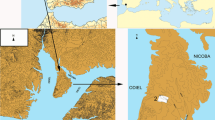Abstract
Recent rescue excavations at Bercy (Paris), a site on the alluvial plain of the Seine valley, yielded plant remains which are associated with the recent occupation phase dating from the middle Neolithic II (Chasséen), when a village was established on the former channel of the river Seine. Various contexts (the channel, the flat lower part of the bank, and several archaeological features) have been studied and 84 taxa have been identified. Cultivated plants are represented by Triticum aestivum/durum, T. dicoccum, T. monococcum and Hordeum vulgare. Among the wild plants with potentially edible fruits or seeds, only very few satisfy the various criteria for association with human activities: Corylus avellana, Vitis sylvestris, Cornus sanguinea, Quercus sp. and Prunus spinosa of which carbonized fruits were also present, were found in archaeological features and were very abundant. Though not found in archaeological features, we consider that Crataegus monogyna (carbonized and well represented) and Rubus spp. (especially abundant) were not deposited there naturally and had also been intentionally collected. Finally, it is suggested that the allochthonous (varied) origin of these taxa is the reason why there are no concentrations of their fruits in the channel. The exploitation of wild seeds and fruits appears to have been very selective. All other wild taxa can be attributed to natural deposition.
Similar content being viewed by others
References
Bakels CC (1978) Four Lineardbandkeramik settlements and their environment: a palaeoecological study of Sittard, Stein, Elsloo and Hienheim. Analecta Praehist Leidensia 11: 1–241
Bakels CC (1984) Carbonized seeds from northern France. Analecta Praehist Leidensia 17: 1–27
Bocquet A, Caillat B, Lundström-Baudais K (1986) Alimentation et techniques de cuisson dans le village néolithique de Charavines. In: Demoule JP, Guilaine J (eds) Le Néolithique de la France: hommage à Gérard Bailloud. Paris, Picard, pp 319–329
Couplan F (1989) Le régal végétal. Plantes sauvages comestibles. Encyclopédie des plantes comestibles de l'Europe, Vol. 1, Editions Equilibres, Flers
Ellenberg H (1974) Zeigerwerte der Gefässpflanzen Mitteleuropas. (1st edn) Scr Geobot 9
Foinard S (1958) Les merveilleuses vertus des plantes. Nice, éd. Sainte Rita
Hopf M (1975) Fosse néolithique d'Entzheim (Bas-Rhin): Études des graines carbonisées, pp 115–117. In: Schmitt G, La transition entre le Néolithique moyen et le Néolithique final en Basse-Alsace, II. Rev Archéol Est France 26 (1): 69–117
Jacomet S (1987) Prähistorische Getreidefunde. Eine Anleitung zur Bestimmung prähistorischer Gersten- und Weizen-Funde. Botanisches Institut der Universität Basel, Abteilung Pflanzensystematik und Geobotanik, Basel
Jacquat C (1989) Hauterive-Champréveyres. 2. Les plantes de l'Age du Bronze. Contribution à l'histoire de l'environnement et de l'alimentation. Archéol Neuchâtel 8
Lieutaghi P (1969) Le Livre des Arbres, Arbustes et Arbrisseaux. ed. R. Morel
Lundström-Baudais K (1986) Étude paléoethnobotanique de la Station III de Clairvaux, pp 311–391. In: Pétrequin P (ed) Les sites littoraux néolithiques de Clairvaux-les-Lacs (Jura), I, Problématique générale, L'exemple de la Station III. Éditions de la Maison des Sciences de l'Homme, Paris
Marinval P (1991) Le Chasséen: problème d'identité, l'approche carpologique, pp 379–382. In: Identité du Chasséen. Actes du Colloque International de Nemours, 1989
Pals JP (1984) Plant remains from Aartswoud, a neolithic settlement in the coastal area. In: Zeist, W van, Casparie, WA (eds) Plants and ancient man, studies in palaeoethnobotany. Balkema, Rotterdam pp 313–321
Rameau JC, Mansion D, Dumé G et al. (1989) Flore forestière française. Guide écologique illustré. Vol 1, Plaines et collines. Institut pour le développement forestier, Paris
Villaret-von Rochow M (1974) Détermination des céréales du niveau XI. Annexe II. In: Pétrequin P (1974) Interprétation d'un habitat néolithique en grotte: le niveau XI de Gonvillars (Haute-Saône). Bull Soc Préhist Franc 2: 489–534
Zeist W van (1970) Prehistoric and early historic food plants in the Netherlands. Palaeohistoria 14: 41–173
Zeist W van (1974) Palaeobotanical studies of settlement sites in the coastal area of the Netherlands. Palaeohistoria 16: 223–371
Zeist W van, Palfenier-Vegter RM (1983) Seeds and fruits from the Swifterbant S3 site, final reports on Swifterbant IV. Palaeohistoria 23: 105–168 (published 1983)
Author information
Authors and Affiliations
Rights and permissions
About this article
Cite this article
Dietsch, MF. Gathered fruits and cultivated plants at Bercy (Paris), a Neolithic village in a fluvial context. Veget Hist Archaebot 5, 89–97 (1996). https://doi.org/10.1007/BF00189438
Received:
Accepted:
Issue Date:
DOI: https://doi.org/10.1007/BF00189438




